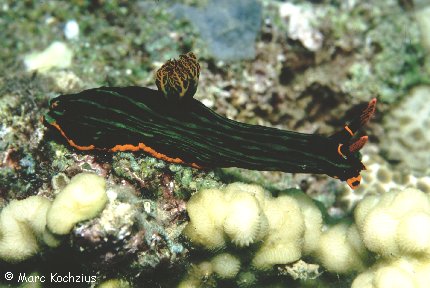|

Whitespotted puffer
(Arothron hispidus) |
Poisons in coral
reefs
|

Bluespotted sting ray
(Taeniura lymma) |
|
“Long-spined sea urchins like violet
glass, sitting in caves of giant sponges. Crawling marine snails and worms,
colours like fire, delicate speckled or like decorated with blue-red pieces
of cloth.”
A. Francé-Harrar, South Seas.
Corals – Jungle – Cannibals (1928) |
|
|
Chemical weapons
Poisonous species you can find in almost
all groups of coral reef animals:
- Snails
- Fishes
- Sponges
- Echinoderms
- Cnidarians
- Sea snakes
The poison helps these animals to:
- arm against enemies
- prevail against competitors
- hunt prey
|

Poisonous tentacles: Anemone (Family Cerianthidae) |
|
|

Danger! Zebra lionfish Dendrochirus zebra |
Poisonous Fishes
Scorpionfishes are armed with poisonous
spines; rays of the dorsal fin connected to a poison gland. This weapon
is used as a defence against predators. To capture their prey they have
a different strategy. Scorpionfishes are well camouflaged lie-and-wait
predators, feeding on small fishes and crustaceans that make the mistake
of venturing near. With lightening speed they open their mouth and the
prey is sucked in.
Pufferfishes produce in their intestines
one of the most poisonous substances in the animal kingdom: Tetrodotoxin.
When in danger, they excrete the poison by the skin. This is a effective
defence against predators. |
|
|
Kleptomania
Nudibranchs do not need a armouring shell,
because they are poisonous and therefore inedible. But they do not produce
the poison themselves, they swallow it with their food. Nudibranches feed
on sponges and absorb toxins produced by the sponges. Some nudibranches
feed on cnidarians and ingest the stinging cells of their prey without
firing them. The stinging cells then are incorporated into the tips of
the finger-like projections covering their back. By this way they are able
to use the stolen weapons for their own protection. |

Poisonous: Nudibranch Nembrotha kubaryana |
|

back |
|

next |
© Marc Kochzius |
|